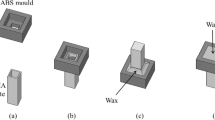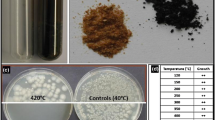Abstract
The causes of Bacillus spore resistance remain unclear. Many structures including a highly compact envelope, low hydration of the protoplast, high concentrations of Ca-chelated dipicolinic acid, and the presence of small acid-soluble spore proteins seem to contribute to resistance. To evaluate the role of internal protoplast composition and hydration, spores of Bacillus subtilis were produced at different osmotic pressures corresponding to water activities of 0.993 (standard), 0.970, and 0.950, using the two depressors (glycerol or NaCl). Sporulation of Bacillus subtilis was slower and reduced in quantity when the water activity was low, taking 4, 10, and 17 days for 0.993, 0.970, and 0.950 water activity, respectively. The spores produced at lower water activity were smaller and could germinate on agar medium at lower water activity than on standard spores. They were also more sensitive to heat (97 °C for 5–60 min) than the standard spores but their resistance to high hydrostatic pressure (350 MPa at 40 °C for 20 min to 4 h) was not altered. Our results showed that the water activity of the sporulation medium significantly affects spore properties including size, germination capacity, and resistance to heat but has no role in bacterial spore resistance to high hydrostatic pressure.





Similar content being viewed by others
References
Alderton G, Snell N (1963) Base exchange and heat resistance in bacterial spores. Biochem Biophys Res Commun 10:139–143
Algie JE (1984) Effect of the internal water activity of bacterial spores on their heat resistance in water. Curr Microbiol 11:293–295
Atrih A, Foster SJ (1999) The role of peptidoglycan structure and structural dynamics during endospore dormancy and germination. Antonie Van Leeuwenhoek 75:299–307
Atrih A, Zollner P, Allmaier G, Williamson MP, Foster SJ (1998) Peptidoglycan structural dynamics during germination of Bacillus subtilis 168 endospores. J Bacteriol 180:4603–4612
Beaman TC, Gerhardt P (1986) Heat resistance of bacterial spores correlated with protoplast dehydration, mineralization, and thermal adaptation. Appl Environ Microbiol 52:1242–1246
Beaman TC, Greenamyre JT, Corner TR, Pankratz HS, Gerhardt P (1982) Bacterial spore heat resistance correlated with water content, wet density, and protoplast/sporoplast volume ratio. J Bacteriol 150:870–877
Black SH, Gerhardt P (1962) Permeability of bacterial spores. IV. Water content, uptake, and distribution. J Bacteriol 83:960–967
Bond WW, Favero MS, Petersen NJ, Marshall JH (1970) Dry-heat inactivation kinetics of naturally occurring spore populations. Appl Microbiol 20:573–578
Cowan AE, Olivastro EM, Koppel DE, Loshon CA, Setlow B, Setlow P (2004) Lipids in the inner membrane of dormant spores of Bacillus species are largely immobile. Proc Natl Acad Sci U S A 101:7733–7738
Fine F, Gervais P (2005) Thermal destruction of dried vegetative yeast cells and dried bacterial spores in a convective hot air flow: strong influence of initial water activity. Environ Microbiol 7:40–46
Foster SJ, Jonstone K (1989) The trigger mechanism of bacterial spore germination. In: Smith I, Slepecky R, Setlow P (eds) Regulation of procaryotic development. American Society for Microbiology, Washington, pp 89–108
Gerhardt P, Beaman TC, Corner TR, Greenamyre JT, Tisa LS (1982) Photometric immersion refractometry of bacterial spores. J Bacteriol 150:643–648
Gould GW (1977) Recent advances in the understanding of resistance and dormancy in bacterial spores. J Appl Bacteriol 42:297–309
Gould GW (2006) History of science-spores Lewis B Perry Memorial Lecture 2005. J Appl Bacteriol 101:507–513
Hawley SA (1971) Reversible pressure–temperature denaturation of chymotrypsinogen. Biochemistry 10:2436–2442
Kang CK, Woodburn M, Pagenkopf A, Cheney R (1969) Growth, sporulation, and germination of Clostridium perfringens in media of controlled water activity. Appl Microbiol 18:798–805
Kim HS, Sherman D, Johnson F, Aronson AI (2004) Characterization of a major Bacillus anthracis spore coat protein and its role in spore inactivation. J Bacteriol 186:2413–2417
Kuwana R, Kasahara Y, Fujibayashi M, Takamatsu H, Ogasawara N, Watabe K (2002) Proteomics characterization of novel spore proteins of Bacillus subtilis. Microbiology 148:3971–3982
Lee SB, Kim KJ (1995) Effect of water activity on enzyme hydration and enzyme reaction rate in organic solvents. J Ferment Bioeng 79:473–478
Magill NG, Cowan AE, Koppel DE, Setlow P (1994) The internal pH of the forespore compartment of Bacillus megaterium decreases by about 1 pH unit during sporulation. J Bacteriol 176:2252–2258
Mason JM, Setlow P (1986) Essential role of small, acid-soluble spore proteins in resistance of Bacillus subtilis spores to UV light. J Bacteriol 167:174–178
Melly E, Genest PC, Gilmore ME, Little S, Popham DL, Driks A, Setlow P (2002) Analysis of the properties of spores of Bacillus subtilis prepared at different temperatures. J Appl Microbiol 92:1105–1115
Melly E, Setlow P (2001) Heat shock proteins do not influence wet heat resistance of Bacillus subtilis spores. J Bacteriol 183:779–784
Moir A (2003) Bacterial spore germination and protein mobility. Trends Microbiol 11:452–454
Moir A, Corfe BM, Behravan J (2002) Spore germination. Cell Mol Life Sci 59:403–409
Nakashio S, Gerhardt P (1985) Protoplast dehydration correlated with heat resistance of bacterial spores. J Bacteriol 162:571–578
Nakayama A, Yano Y, Kobayashi S, Ishikawa M, Sakai K (1996) Comparison of pressure resistances of spores of six Bacillus strains with their heat resistances. Appl Environ Microbiol 62:3897–3900
Norrish RS (1966) An equation for the activity coefficients and equilibrium relative humidities of water in confectionery syrups. J Food Technol 1:25–39
Paidhungat M, Setlow B, Daniels WB, Hoover D, Papafragkou E, Setlow P (2002) Mechanisms of induction of germination of Bacillus subtilis spores by high pressure. Appl Environ Microbiol 68:3172–3175
Paidhungat M, Setlow B, Driks A, Setlow P (2000) Characterization of spores of Bacillus subtilis which lack dipicolinic acid. J Bacteriol 182:5505–5512
Perrier-Cornet JM, Hayert M, Gervais P (1999) Yeast cell mortality related to a high-pressure shift: occurrence of cell membrane permeabilization. J Appl Microbiol 87:1–7
Popham DL, Sengupta S, Setlow P (1995) Heat, hydrogen peroxide, and UV resistance of Bacillus subtilis spores with increased core water content and with or without major DNA-binding proteins. Appl Environ Microbiol 61:3633–3638
Sarasanandarajah S, Kunnil J, Chacko E, Bronk BV, Reinisch L (2005) Reversible changes in fluorescence of bacterial endospores found in aerosols due to hydration/drying. J Aerosol Sci 36:689–699
Setlow P (2003) Spore germination. Curr Opin Microbiol 6:550–556
Setlow P (2006) Spores of Bacillus subtilis: their resistance to and killing by radiation, heat and chemicals. J Appl Microbiol 101:514–525
Setlow P (2007) I will survive: DNA protection in bacterial spores. Trends Microbiol 15:172–180
Setlow B, Setlow P (1980) Measurements of the pH within dormant and germinated bacterial spores. Proc Natl Acad Sci U S A 77:2474–2476
Setlow B, Setlow P (1993) Binding of small, acid-soluble spore proteins to DNA plays a significant role in the resistance of Bacillus subtilis spores to hydrogen peroxide. Appl Environ Microbiol 59:3418–3423
Setlow B, Setlow P (1995) Small, acid-soluble proteins bound to DNA protect Bacillus subtilis spores from killing by dry heat. Appl Environ Microbiol 61:2787–2790
Ulanowski Z, Ludlow IK, Waites WM (1987) Water content and size of spore components determined by laser diffractometry. FEMS Microbiol Lett 40:229–232
Vreeland RH, Rosenzweig WD, Powers DW (2000) Isolation of a 250 million-year-old halotolerant bacterium from a primary salt crystal. Nature 407:897–900
Warth AD (1978) Molecular structure of the bacterial spore. Adv Microb Physiol 17:1–45
Wood JM, Bremer E, Csonka LN, Kraemer R, Poolman B, van der Heide T, Smith LT (2001) Osmosensing and osmoregulatory compatible solute accumulation by bacteria. Comp Biochem Physiol Part A Mol Integr Physiol 130:437–460
Wuytack EY, Boven S, Michiels CW (1998) Comparative study of pressure-induced germination of Bacillus subtilis spores at low and high pressures. Appl Environ Microbiol 64:3220–3224
Author information
Authors and Affiliations
Corresponding author
Additional information
An erratum to this article can be found at https://doi.org/10.1007/s00253-008-1558-3
Rights and permissions
About this article
Cite this article
Nguyen Thi Minh, H., Perrier-Cornet, JM. & Gervais, P. Effect of the osmotic conditions during sporulation on the subsequent resistance of bacterial spores. Appl Microbiol Biotechnol 80, 107–114 (2008). https://doi.org/10.1007/s00253-008-1519-x
Received:
Revised:
Accepted:
Published:
Issue Date:
DOI: https://doi.org/10.1007/s00253-008-1519-x




